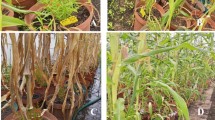Summary
Accessions representing twenty eight landraces of maize were assessed for susceptibility to the maize weevil, Sitophilus zeamais in standardized resistance tests. Susceptibility parameters such as weight loss of grain, number of insect progeny produced, the Dobie index of susceptibility, and oviposition on grain were found to vary significantly by genotype, with exceptional resistance found in accessions representing the Naltel, Chapalote and Palomero landraces. As in improved genotypes, susceptibility was negatively correlated to phenolic and protein content of the variety tested but positively correlated to moisture content. A detailed analysis of the phenolics revealed the presence of diferulate which may contribute to mechanical resistance of the seed by cross-linking of cell wall hemicelluloses. A canonical discriminant analysis of the resistance data suggests that most of the five landrace groupings are significantly different. The ancient indigenous and prehistoric mestisos groupings are sources of resistant genotypes.
Similar content being viewed by others
References
Camussi, A., 1979. Numerical taxonomy of Italian populations of maize based on quantitative traits. Maydica XXIV: 161–174.
Cervantes, T., M.M. Goodman, E. Casas & J.O. Rawlings, 1978. Use of genetic effects and genotype by environmental interactions for the classification of Mexican races of maize. Genetics 90: 339–348.
Classen, D., J.T. Arnason, J.A. Serratos, J.D.H. Lambert, C. Nozzolillo & B.J.R. Philogene, 1990. Correlation of phenolic acid content of maize to resistance to Sitophilus zeamais, the maize weevil in CIMMYT's collections. J. Chem. Ecol. 16 (2): 301–315.
Dobie, P., 1977. The contribution of the Tropical Stored Products Centre to the study of insect resistance in maize. Trop. Stored Prod. Information 34: 7–22.
Doebley, J.F., M.M. Goodman & C.W. Stuber, 1986. Isozyme variation in the races of maize of Mexico. Amer. J. Bot. 72: 629–639.
Eraso, F. & R.D. Hartley, 1990. Monomeric and dimeric phenolic constituents of plant cell walls. J. Sci. Food Agric. 51: 163–170.
Fincher, G.B. & B.H. Stone, 1986. Cell walls and their components in cereal grain technology. Adv. Cer. Sci. Tech. 8: 207–295.
Fortier, G., J.T. Arnason, J. Lambert, C. Nozzolillo & B.J.R. Philogène, 1982. Local and improved corn varieties in small farm agriculture in Belize C.A. Phytoprotection 63: 68–78.
Goodman, M.M., 1978. A brief survey of the races of maize and current attempts to infer racial relationships. In: D.B. Walden (Ed.), Maize Breeding and Genetics. International Maize Symposium. Sept. 1977. Wiley and Sons, New York, pp. 143–158.
Goodman, M.M. & R. Mck.Bird, 1977. The races of maize IV: Tentative grouping of 219 Latin American races. Econ. Bot. 31: 204–221.
Kato, Y. & D.J. Nevins, 1985. Isolation and identification of O-(5-O-feruloyl-α-L-arabinofuranosyl)-(1→3)- O-β-D-xylopyranosyl-(1→4)-D-xylopyranose as a component of Zea shoot cell walls. Carbohydr. Res. 137: 139–150.
Mck.Bird, R.M., 1982a. Systematics of Zea and the selection of experimental material. In: W.F. Sheridan (Ed.), Maize for Biological Research. North Dakota, pp. 341–350.
Mck.Bird, R.M., 1982b. Maize and teosinte germplasm banks. In: W.F. Sheridan (Ed.), Maize for Biological Research. North Dakota, pp. 341–350.
Pussayanawin, V., D.L. Wetzel & R.G. Fulcher, 1988. Fluorescence detection and measurement of ferulic acid in wheat milling fractions by microscopy and HPLC. J. Agric. and Food Chem. 36: 515–520.
Rao, C.R., 1973. Linear Statistical Inference and its Applications. John Wiley and Sons, New York.
Reid, L., J.T. Arnason, C. Nozzolillo, R.H. Hamilton, 1990. Resistance of maize to the European corn borer, Ostrinia nubilalis, as related to the geographical origin of maize. Can. J. Bot. 68: 311–316.
Sen, A., S.S. Miller, J.T. Arnason & R.G. Fulcher, 1991. Quantitative determination by HPLC and microspectrofluorimetry of phenolic acids in maize kernels. Phytochemical Analysis 2: 225–229.
Vaughan, D.A. & L.A. Sitch, 1991. Gene flow from jungle to farmers. Bioscience 41: 22–28.
Wellhausen, E.J., L.M. Roberts, E. Hernandez & P.C. Mangelsdorf, 1952. Races of Maize in Mexico: Their Origin, Characteristics and Distribution. Bussey Institution of Harvard Univ.
Waiss, A.C., B.G. Chan, C.A. Elliger, B.R. Wiseman, W.W. McMillan, N.W. Widstrom, M.S. Zuber & A.J. Keaster, 1979. Maysin, a flavone glycoside from corn silks with antibiotic activity toward corn earworm. J. Econ. Entomol. 72: 256–258
Author information
Authors and Affiliations
Rights and permissions
About this article
Cite this article
Arnason, J.T., Baum, B., Gale, J. et al. Variation in resistance of Mexican landraces of maize to maize weevil Sitophilus zeamais, in relation to taxonomic and biochemical parameters. Euphytica 74, 227–236 (1993). https://doi.org/10.1007/BF00040405
Received:
Accepted:
Issue Date:
DOI: https://doi.org/10.1007/BF00040405



